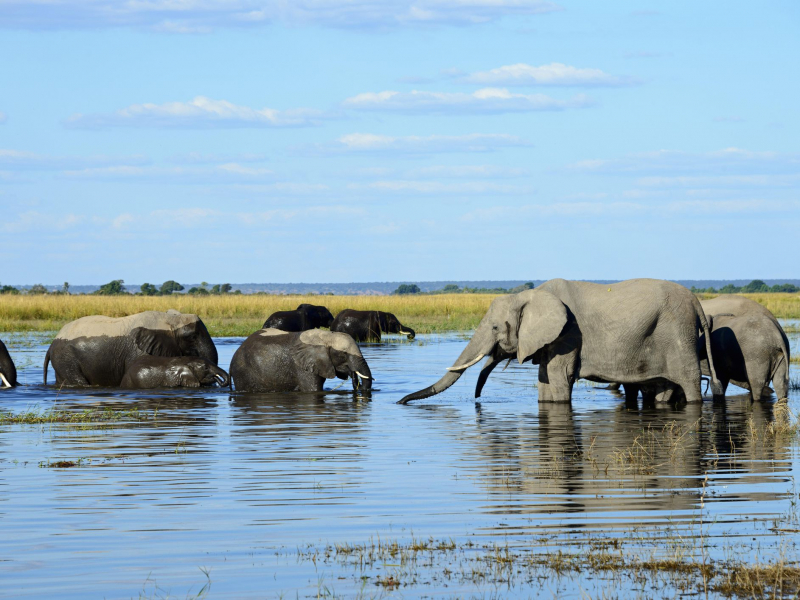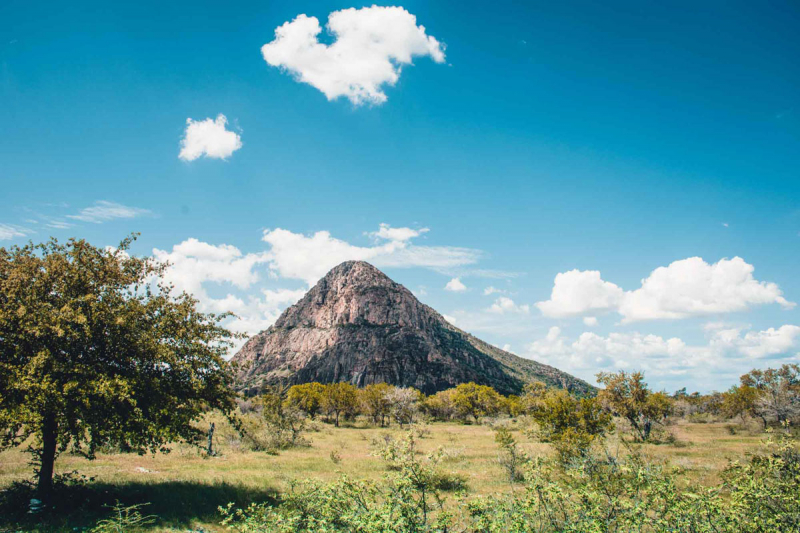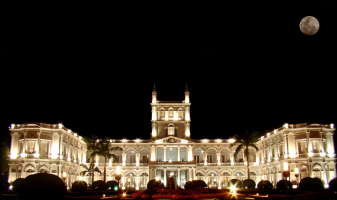Top 10 Best Places to Visit in Botswana
Botswana is one of the most popular countries for tourists visiting the African continent. With its incredible national parks, all five famous large animals, ... read more...and a diverse mix of landscapes, between desolate salt flats and flooded marshlands. It's a great place to enjoy many natural landscapes in Africa, from rivers to cruises and walking safaris. However, with an area of nearly 600,000 square kilometers, there are plenty of places in Botswana to visit. To help you decide what to do in Botswana during your travels, here are ten of the best places to visit in the country.
-
If you are a lover of nature and wildlife and want to spend quality time in the southern part of Africa, book an appointment with Botswana.
The Okavango Delta is one of the most visited places in Botswana that are looking for the Okavango Delta Wild Africa travel experience. Bordering the Kalahari Desert, the famous Okavango offers a refreshing experience of taking a ride in a mokoro canoe. The plain stretches to about 15 000 square kilometers of the Kalahari Desert in northern Botswana. Many call it the 'jewel of the Kalahari' because of the diversity of wildlife species and habitats found in more than 2 million hectares of land that make it the largest intact inland plain in the world.
Several critically endangered species live in the Okavango Delta, including the African wild dog, cheetah, white rhinoceros, and black rhinoceros. It is a popular area of the country for people to go on a safari, especially from July to September, as many species migrate throughout the region. It is one of the most beautiful and diverse natural spaces in Africa, and if you're looking to discover the best of the Botswana wilderness, look no further than the county.
Location: North-western Botswana

Okavango Delta. Photo: seeafricatoday.com 
Okavango Delta. Photo: nationalgeographic.org -
Many describe the Moremi Game Reserve as one of the most beautiful in all of Africa, making it high on most people's list of places to visit in Botswana. Spread across the center and east of the Okavango Plain, the reserve was first set aside by the local BaTawana people in 1962 and maintained for many years so that the wildlife living here could flourish.
This park is an amazingly complex area consisting of reed and acacia forests, floodplains, and lagoons, covering an area of 5,000 square kilometers. Only about 30% of the resources are maritime, with the rest located in the Okavango Delta. Moremi is home to nearly 500 species of birds, including Buffalo, Giraffe, Lion, Leopard, Garland, Ghetto, Hyaena, Chapala, Impala, and wildlife of Africa. The most important species are birds such as birds and forest dwellers.
The Moremi Reserve is the perfect place to enjoy the game's stunning views of the savanna and lagoon. The endangered African leopard and wild dog are also native to heavily wooded areas. Chobe National Park, centered on the Moremi Game Reserve, sits to the northeast.
Location: Central and eastern areas of the Okavango

Moremi Game Reserve. Photo: bwindiugandagorillatrekking.com 
Moremi Game Reserve. Photo: discoverafrica.com -
The Makgadikgadi Pans in the Kalahari stretch for 16,000 km², making them the largest salt pan in the world, making them Botswana's top tourist attraction. Formed by an ancient lake that has now dried up, the huge stretches of shimmering, ruined Makgadikgadi Pans land stretch for miles, offering an almost otherworldly experience of the northeastern landscape of the country.
Remnants of an ancient lake, the pans are interspersed with the sandy desert and vegetation of the Njuca Hills. Here there are acacia bushes, and along the banks of the Boteti, there is a riverside forest.
One of Africa's largest populations of zebras makes this land of white sand and salt their home. When rain falls during the wet season, the pans fill with water, attracting large flocks of flamingos, herds of zebras, springboks, and wildebeests. They closely follow predators, making for a great match.
During the dry season, Makgadikgadi Pans are deserted and barren, providing a perfectly flat surface for hiking, mountain biking, camping, also the chance to find fossils of creatures that would have been living in the water millions of years ago.
Location: North-eastern Botswana

Makgadikgadi Pans. Photo: exploring-africa.com 
Makgadikgadi Pans. Photo: andbeyond.com -
Chobe National Park is Botswana's third-largest national park. It is named after the Chobe River, which flows along the northern boundary of the park, forms the border between the country of Botswana and the Caprivi strip of Namibia. The river is the region's heartbeat, providing year-round water for the numerous animals and birds that call the park home. Its fertile floodplains combine with grasslands, reeds, and dense shrubs to create a patchwork of habitats that provide shelter for one of the most game-focused sites in the country. Africa.
If you are looking for a place to visit in Botswana that will give you a glimpse of all the natural habitats found in the country, this park is the perfect place for you. It has four different ecosystems, including rivers, floodplains, swamps, grasslands, savannas, and forests.
The Chobe River is a highlight of the area. It runs along the northern border of the park, provides a fantastic route for a river cruise or safari, giving you the chance to experience the region's land and observe wildlife congregating at the water's edge.
Chobe National Park is known for its huge herds of elephants, many of which contain hundreds of animals. In total, about 120,000 elephants live within the park's boundaries. The buffalo herd is almost as big as the herd, and the park is famous for its strong lions. The Chobe River forms an ideal habitat for water-dependent animals, including hippos, Nile crocodiles, mercury, and the endangered red lechwe.
Bird watching is also a favorite among park visitors, as the park has more than 450 species.
Location: Northern Botswana

Chobe National Park. Photo: chobenationalpark.co.za 
Chobe National Park. Photo: tripsavvy.com -
The Central Kalahari Game Reserve (CKGR for short) is the second-largest reserve in the world and by far the most remote in South Africa. CKGR covers an area of 52,000 square kilometers and is home to rhinoceros, black-maned lions, and desert-adapted elephants, among other prominent game species.
A testament to the history of Central Kalahari, it is inhabited by the San, an ancient hunter-gatherer society beyond its time with superb hunting skills and an ability to adapt to environmental challenges harsh fields caused by this enormous desert.
This part of the country is largely uninhabited, with most inhabitants belonging to private conservation camps or parts of bush tribes that have lived in the area and inland for thousands of years. The reserve was created to protect a space where these people could continue their traditional way of life. Now only a small number of visitors are allowed into the park every year to preserve the landscape and maintain the natural balance of life.
Unlike other Botswana safari destinations, January to April is the best time to visit. During this green season in Botswana, the beautiful interdune valley becomes lush with vegetation, attracting thousands of springboks, gemsbok, ostriches, wildebeest, and giraffe. The green season also heralds the spawning season, where hundreds of young give birth, creating some truly exciting predator-prey interaction. You also have the opportunity to take excellent photos.
Location: Kalahari Desert, Botswana

Central Kalahari Game Reserve. Photo: tstafrica.com 
Central Kalahari Game Reserve. Photo: botswana-holidays.com -
Nxai Pan National Park is a reserve located in the northeastern part of Botswana, including Nxai Pan. This large salt pan forms part of the larger Makgadikgadi Pan, located in northeast Botswana. Nxai Pan is a fossil lakebed, and access to this natural wonder is by air or road transfers.
Whether you visit in the dry season, when the soil crumbles underfoot, and the baobab trees stand out among the endless stretches of landscape, or in the wet season, when water pools across the pan and green vegetation sprouts everywhere, it's a really beautiful part of Botswana that should be on your itinerary.
Seasonal rainfall over the grasslands of Nxai Pan National Park attracts large herds of wildlife migrating from the south. Predators lurk in pans to stalk their prey and lead to an unforgettable wildlife experience for visitors. Nxai National Park is famous as a seasonal home to populations of zebras, cheetahs, elephants, and spectacular acacia vegetation.
The highlight of this tourist attraction is the famous Baines Baobabs with its seven giant baobab trees located right at the edge of Kudiakam Pan in the national park over 20 meters high and believed to be over 1000 years old. If you're visiting the country during the high season, Nxai Pan National Park is a great alternative to Makgadikgadi Pans, which can get pretty busy during the popular vacation months.
Location: North-eastern Botswana

Nxai Pan National Park. Photo: botswana.co.za 
Nxai Pan National Park. Photo: wikidata.org -
Of the many parks, there are only two Unesco World Heritage Sites in Botswana. While most tourists flock to the Okavango Delta, Tsodilo Hills remains off the beaten tourist track.
Tsodilo Hills arises from a straight, spirit-level landscape and is visible from a great distance. Dubbed the Louvre of the desert, this is a place of reverence and worship for many. The hills rise emotionally from the plains of the Kalahari.
Inscribed as a World Heritage Site in 2001, Tsodilo Hill protects more than 4,000 ancient art paintings thought to have been in the rock for more than 30,000 years.
Tsodilo Hill consists of three prominent peaks, known as Male, Female, and Child. Visitors can soak up the undeniable spirit of this sacred space on tour through the hills with an area historian.
The most accessible (and therefore most popular) route is the Rhino route, which loops through the medium-sized Female Hills. This hill is so named because it is home to several ancient rock paintings on themes of fertility. This trail will take you past the legendary Van der Post Panel, ocher rhinoceros drawings, and even images of whales and a penguin.
The country is mostly flat, but Tsodilo boasts Botswana's highest peak. If you want a challenging hike, the top of Male Hill is a great spot. The walk starts easily with the Lion's Road. Past its eponymous rock picture. Then a steep ascent ahead takes you 1,489, above sea level.
There is also an interesting little museum for you to visit.
Location: North-west Botswana

Tsodilo Hills. Photo: blog.tracks4africa.co.za 
Tsodilo Hills. Photo: africanrockart.org -
One of Africa's most unique parks, the red dunes of the Kgalagadi Transfrontier and the seemingly unholy desert make it, unlike anything you'll encounter elsewhere.
Kgalagadi Transfrontier National Park was once Botswana's Gemsbok National Park and South Africa's Kalahari Gemsbok National Park before the two countries began joint conservation efforts and formed the world's first Transfrontier Park. Located just north of Botswana, its remote location means it's one of the country's lesser-known national parks. But well worth a visit if you want to enjoy a protected enclave wild without many other tourists.
One of the most famous things in Kgalagadi is its red dunes and dry riverbed, which contain hundreds of fossils that suggest life once inhabited this vast desert and salt pan. The name of the park means 'place of great thirst,' so expect plenty of dry, sparse, and stunning landscapes where lions, cheetahs, leopards, and hyenas all roam the ladder.
Jaguars and hyenas are also popular attractions, preying on wildebeest in abundance. Larger herbivores aren't present, but the park is one of the best places in South Africa to look for leopards. The elusive pangolin is also a popular animal to spot in the wild.
Location: South Africa-Botswana border

Kgalagadi Transfrontier National Park. Photo: joinupsafaris.com 
Kgalagadi Transfrontier National Park. Photo: shadowsofafrica.com -
If you are looking for places in Botswana for a safari, then Savuti National Park is one of the most highly recommended destinations. Found right on the western corner of Chobe National Park, it's an area of about 5000 square kilometers with safari accommodation options ranging from classic desert campsites to lodges luxury with its hot tub overlooking the plains.
One of the most famous parts of this national park is the Savuti Canal, which has a really interesting history. It's hard to imagine this area once lay on the bottom of the inland sea until one had a closer look at the desolate landscape. On drying up, the lake left the Okavango Delta, Mababe Lowland, Lake Xau, Lake Ngami, Nxai Pan, and Makgadikgadi Pans. The Magwikhwe Sands to the north represent ancient coastlines, while the road from Maun to Savute follows the edge of the Mababe Depression, of which the deepest part is the Savute Marsh. The dead trees in the marsh are the result of the recent flooding (the only part filled in recent history) and the drying up of the Savute Canal.
The Savute Canal has a fascinating history of flooding and drying independent of the rainy and flood seasons elsewhere. That attracts many classical African wildlife species to drink or hunt beside the water and live in the open areas left behind.
Location: South west of Chobe National Park

Savuti National Park. Photo: duniart.com 
Savuti National Park. Photo: wetu.com -
Head north to the Okavango Plain in Botswana, you'll find the Linyanti Wetlands. A beautiful area with many games, stretching to the border of Namibia. Linyanti is unique as it blends two stunning landscapes: the winding floodplains of Okavango and the dense forest of Chobe.
As a result of this combination of different habitats, Linyanti, Botswana, is full of beautiful wildlife, plants, and animals. A hunt in the area gives you the chance to hear the warm purrs of hippos, the raucous calls of lions, and the giggles of hyenas.
If you're looking for a memorable safari experience, Linyanti Wetlands is a must-visit. Keep reading to learn more about these wetlands, their wildlife, and the best way to experience them.
The Linyanti Wetlands are a hidden gem of Botswana as they offer secluded tranquility and no crowds. It makes it possible to explore the wilderness in the swamp with intimate driving and hunting games. With no one else around, you'll feel as if you were the last people on earth!
Location: North of Botswana

Linyanti Wetlands. Photo: gondwanatoursandsafaris.com 
Linyanti Wetlands. Photo: mackair.co.bw































